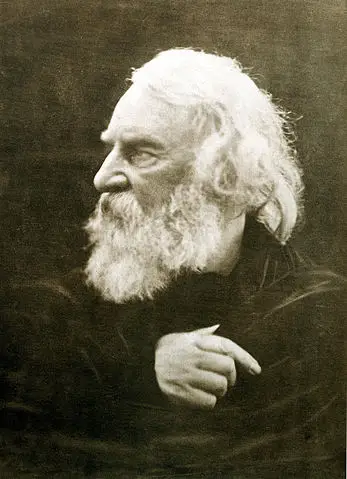Henry Wadsworth Longfellow
Born: 1807
Birthplace: Maine
Died: 1882
Henry Wadsworth Longfellow was an American poet and writer. His works talked about many subjects, including overcoming hardships and life in America before and after the Civil War.

He became the most popular writer of his time in the United States, but his published works also gained fame in the entire English-speaking world. In England alone, there were 24 publishing companies that published his books.
Those that admired him included Charles Dickens, Charles Baudelaire, and Abraham Lincoln.
- Longfellow was born in what was then Massachusetts but later became Portland, Maine. His father was a Portland lawyer as well as a Congressional member, and his mother was the daughter of a Revolutionary War hero, and he had seven brothers and sisters.
- Longfellow had the extensive international experience when he studied in Europe after he graduated from Bowdoin College. He spent three years in Europe studying modern languages and then became a teacher at Bowdoin when he returned home.
- He married one of his previous classmates, Mary Storer Potter, in 1831. Longfellow published “Outre Mer” (Overseas), which described his journeys and was his first book. In 1835 he decided to make his second trip to Europe. However, his world was turned upside down when his wife died of a miscarriage. Longfellow was grief-stricken and spent a year in Switzerland and Germany.
- Once Longfellow came home again in 1836, he was offered a position at Harvard and accepted it. He devoted three years to teaching and writing, and then when he was thirty-two years old, he published “Voices of the Night,” which was his first collection of poems. He published “Ballads and Other Poems” in 1841. Many of the themes of his writings were about people overcoming obstacles, even in a nation that was struggling. His works were inspirational and popular.
- Longfellow found that his job as a Harvard professor made him too busy to continue writing. By this time, he had met a young woman from Boston, Frances Appleton, and she had refused to marry him. Frances eventually agreed to his marriage proposal, and the couple enjoyed eighteen happy years and six children.
- With a renewed sense of confidence and joy in his life, Longfellow published “Evangeline” in 1847. It was a poem that is described as “book-length,” and the topic was what we now refer to as “ethnic cleansing,” taking place in Nova Scotia.
- Longfellow had a deep concern for humanity and wanted to devote more time to writing. He decided to leave his position in 1854, and he began to concentrate on his poetry. He published his lengthy poem “Hiawatha” about the lives of Native Indians, and “The Courtship of Miles Standish and Other Poems.” Although both books became incredibly popular, Longfellow’s attentions were now on the possibility of civil war. He was very patriotic and felt that he should write something that offered a sense of courage. He then wrote, “Paul Revere’s Ride.”
- Tragedy again struck Longfellow in 1861 when his wife was using wax to seal an envelope, which was how it was done in their day. She caught her dress on fire, and Longfellow couldn’t put it out. Frances Longfellow died the next day, and in grief, Longfellow simply couldn’t write or publish anything for the next two years. Before Frances’ death, he had written “Tales of a Wayside Inn,” and he did publish that in 1863.
- By 1865 Longfellow was fifty-eight years old, and his popularity at home and abroad continued to grow. The Civil War was over by that time, and Longfellow continued to write. He published additional books of poetry from 1866 through 1880.
- With failing health, Longfellow died on March 24, 1882.
Q&A:
What was the lengthy poem that Longfellow wrote about Native Indians?
Hiawatha
What college did Longfellow accept a position with after he returned from Europe?
Harvard
What patriotic poem did Longfellow write as inspiration and courage for a possible Civil War?
Paul Revere’s Ride
Who were some of the famous people that admired Longfellow’s work?
Charles Dickens, Charles Baudelaire, and Abraham Lincoln
What poetic book did Longfellow write that related to what we “ethnic cleansing” today?
Evangeline
How long did Longfellow spend in Europe during his first trip?
3 years



